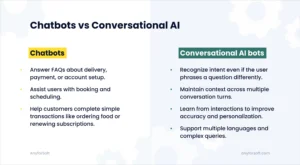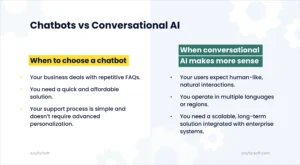Chatbots vs Conversational AI: The Difference Explained
Asking the difference between a chatbot and conversational AI is like asking the difference between cherry pie and cooking. Even though these terms are related, they’re not synonymous. A chatbot is a tool that emulates human-like conversations with users, while conversational AI is the technology that makes the creation of sophisticated AI-powered chatbots possible.
That constitutes all the difference, and we could finish here. But we won’t because otherwise you won’t learn the fine details, and we won’t be able to rank such a short article on Google. So let’s help each other, shall we?
In the following paragraphs, we will discuss the chatbot vs conversational AI question and elaborate on the difference between the two terms. You will:
- Learn what a chatbot and a conversational artificial intelligence chatbot are.
- See some examples of chatbots and conversational AI implementations.
- Discover how chatbots vs conversational AI systems differ and how they can complement each other in real business scenarios.
Without further ado, let’s get started!
What is a chatbot?
A chatbot is a software application designed to simulate conversation with users through text or voice. Traditional chatbots are typically rule-based – they rely on predefined scripts and decision trees to respond to user input. If you ask a question that matches their programmed rules, they provide the correct answer; if not, they might fail to respond meaningfully.
Chatbots are often deployed in scenarios where customer needs are predictable, such as:
- Answering FAQs about delivery, payment, or account setup.
- Assisting users with booking and scheduling.
- Helping customers complete simple transactions like ordering food or renewing subscriptions.
Shortly, chatbot solutions help elevate customer experience while decreasing customer service costs. No wonder the chatbot market is forecast to reach around 27.29 billion by 2030.
Because they are relatively easy to build and quick to launch, chatbots are cost-effective for businesses with straightforward support needs. That’s why businesses eagerly invest in chatbot development. However, their limitations become evident when conversations get complex or require deeper understanding. This is where the chatbot vs conversational agent distinction matters most: while chatbots follow scripts, agents powered by AI can adapt dynamically.
What Is Conversational AI?
Conversational AI is a broader concept that includes advanced technologies like natural language processing (NLP), natural language understanding (NLU), and machine learning to create more sophisticated, human-like interactions. Instead of following fixed rules, a conversational AI chatbot interprets intent, understands context, and generates responses that feel natural.
Unlike traditional bots, conversational AI bots can:
- Recognize intent even if the user phrases a question differently.
- Maintain context across multiple conversation turns.
- Learn from interactions to improve accuracy and personalization.
- Support multiple languages and complex queries.
Thanks to these capabilities, a conversational AI-based bot acts less like a rigid script and more like a digital assistant. For example, instead of just answering whether a product is available, it can also recommend alternatives, upsell related products, and remember previous customer preferences.
This makes conversational AI especially useful for industries where user journeys are complex, expectations are high, and personalization drives loyalty. In short, chatbot vs conversational AI is a matter of flexibility and intelligence – AI goes beyond simple automation to create meaningful engagement.

Chatbots vs Conversational AI: Feature Comparison
When it comes to chatbots vs conversational AI, the differences become clearer across several dimensions.
Interaction style – scripted vs dynamic
- Chatbots: Follow predefined rules, often leading to repetitive interactions.
- Conversational AI: Generates dynamic responses based on real-time context and intent recognition.
Complexity and context awareness
- Chatbots: Limited to basic queries and predefined scenarios.
- Conversational AI: Manages nuanced conversations and retains context across multiple exchanges.
Learning capabilities and personalization
- Chatbots: Do not learn or improve without manual updates.
- Conversational AI bots: Continuously learn from interactions, adapt to user needs, and improve accuracy over time.
Integration and scalability
- Chatbots: Easy to integrate with single systems but limited when scaling across multiple platforms.
- Conversational AI: Designed for seamless integration with CRM, ERP, LMS, and other enterprise systems, making them highly scalable.
Cost and time to deploy
- Chatbots: Faster and cheaper to implement. Ideal for businesses with limited budgets.
- Conversational AI: Higher initial investment but offers long-term ROI through automation and personalization.
Maintenance and optimization needs
- Chatbots: Require manual updates when processes or FAQs change.
- Conversational AI: Needs continuous monitoring but self-improves with time, reducing manual effort.
Real-World Examples
Theory is useful, but nothing illustrates the chatbot vs conversational AI debate better than real-world implementations. Let’s look at how companies across industries use both technologies.
Chatbot case studies
- Vodafone UK – TOBi. Vodafone introduced TOBi, a chatbot conversational AI hybrid, to manage over a million customer interactions per month. TOBi handles billing inquiries, troubleshooting, and account management, achieving a first-contact resolution rate of around 70%. This significantly reduced wait times and boosted agent productivity.
- Carrefour – Hopla. Retail giant Carrefour developed Hopla, a conversational bot designed to improve the shopping experience. Hopla helps customers discover products, recommends items based on preferences and dietary needs, and even supports sustainability initiatives. The result: higher engagement and increased cart values.
- Eye-oo with Tidio. Eye-oo, an Italian e-commerce store, turned to Tidio’s AI-driven chatbot to improve support and sales. The bot responds instantly to inquiries, provides tailored product suggestions, and automates routine customer support tasks. This led to faster response times and noticeable revenue growth.
These examples show how chatbots — whether rule-based or enhanced with light AI — can reduce costs, increase efficiency, and improve the customer experience, especially in high-volume retail and telecom environments.
Conversational AI case studies
- Lufthansa. Lufthansa, one of Europe’s largest airlines, implemented conversational AI bots across multiple languages and channels to manage disruptions and booking inquiries. These agents now handle over 16 million conversations, managing 10,000+ daily interactions — proving the scalability of conversational AI in high-stress industries.
- Virgin Pulse. Virgin Pulse deployed a conversational AI chatbot integrated with Zendesk LiveChat to handle member support. With 97% intent recognition accuracy across 29 topic areas, it doubled user sessions from 12,000 to 30,000 and increased automation rates from 3% to 40% in just a month.
- Henkel. Henkel created a conversational AI-based bot to provide customers with personalized stain treatment advice. By analyzing over 2,500 fabric, surface, and substance combinations, the bot delivers real-time recommendations, enhancing both engagement and brand trust.
- E.ON. Energy provider E.ON uses more than 30 AI agents to support both customers and employees with tasks like meter readings and contract management. These bots now automate 70% of two million annual conversations, saving significant resources while ensuring customer satisfaction.
These cases highlight the difference between chatbot and conversational AI in practice: while chatbots are excellent for handling routine tasks at scale, conversational AI bots can adapt to complex contexts, support multiple languages, and deliver highly personalized experiences.
Choosing the Right Solution for Your Business

When to choose a chatbot
- Your business deals with repetitive FAQs.
- You need a quick and affordable solution.
- Your support process is simple and doesn’t require advanced personalization.
When conversational AI makes more sense
- Your users expect human-like, natural interactions.
- You operate in multiple languages or regions.
- You need a scalable, long-term solution integrated with enterprise systems.
Can they work together?
Yes. Many companies deploy conversational AI and chatbots side by side. For example, a conversational bot can manage complex queries, while a simple chatbot handles routine FAQs. This hybrid approach balances cost efficiency and advanced functionality.
Implementation Considerations
Business goals and user expectations
Start with a clear understanding of what you want to achieve. Do you want to reduce call center costs, increase self-service adoption, or improve customer satisfaction? Align the technology with these goals.
Required infrastructure and team readiness
Chatbot vs AI implementation differs in complexity. While chatbots need minimal setup, conversational AI requires a stronger technical foundation, including integration with existing systems and possibly machine learning expertise.
Ongoing monitoring and improvement
Neither solution is “set it and forget it.” Continuous monitoring, optimization, and updates are crucial for both chatbot conversational AI projects and simpler bots. Our findings indicate that companies that actively refine their bots see up to 30% higher customer satisfaction scores compared to those that don’t.
Conclusion
The chatbot vs AI debate is not about which is universally better—it’s about which is better for your specific needs.
- Chatbots are simple, fast, and cost-effective.
- Conversational AI bots offer scalability, personalization, and long-term value.
In many cases, a hybrid approach brings the best results.
Drawing on our own experience, we can confirm that the choice often depends on the balance between budget, complexity, and customer expectations. Whatever path you choose, implementing the right solution can transform customer interactions into meaningful, efficient experiences.
If you’re considering adopting a chatbot conversational AI solution or need guidance on how to integrate one into your digital ecosystem, AnyforSoft can help.
FAQ
Can chatbots understand user intent like conversational AI?
No. Chatbots rely on keywords and scripts, while conversational AI bots use NLU to interpret intent.
What is NLU and why is it important?
Natural language understanding (NLU) allows conversational AI to comprehend meaning and context, enabling more accurate and human-like responses.
Do I need machine learning to build a chatbot?
Not for traditional chatbots. But for a conversational AI bot, machine learning is a key component that powers learning and adaptation.
How do chatbots and conversational AI impact customer satisfaction?
Our study shows that conversational AI and chatbots both improve satisfaction by reducing response times. However, conversational AI drives stronger engagement because of its personalized approach.
Can conversational AI handle multiple languages or complex queries?
Yes. This is one of the main advantages of conversational AI vs chatbot solutions. A conversational artificial intelligence chatbot can manage multilingual and context-rich interactions far more effectively than rule-based bots.








